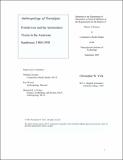Anthropology of nostalgia : primitivism and the antimodern vision in the American Southwest, 1880-1930
Author(s)
York, Christopher W. (Christopher Warren), 1972-
DownloadFull printable version (32.31Mb)
Other Contributors
Massachusetts Institute of Technology. Dept. of Comparative Media Studies.
Advisor
William Uricchio.
Terms of use
Metadata
Show full item recordAbstract
Introduction: Zoo, garden, arcade--three places emblematic of European society's pleasure in and subjugation of animal and plant nature, of the texture of civilized life in a world created by Industry and Progress. This triad, it seems, would stand in opposition to Lummis' oft-repeated formula of "sun, silence, and adobe," and the vision of stillness in the Southwestern hinterland that it evokes. Indeed, few other regions of the United States have so consistently nurtured the cult of the primitive and the peasant that inheres in Lummis' simple paean to adobe. Indian and Hispano both build from adobe; and it, being earth, absorbs these populations back into the land, wedding artisanal, agrarian, and pastoral lives into an integrated vision of ethnicity and region, a spirit of the desert and of the sky. Here only, the modernist regional aesthete would argue, could the authentic American pastoral be found: "there is that genuineness of unfettered simplicity; the closeness to elemental realities in peasant life, which only in New Mexico, of all states, is indigenous." Hence the modernist Southwest was manifestly not a place of Victorian zoos, picturesque gardens, or Parisian shopping arcades. And yet, I would like to argue, the evanescent afterimages of these places--the ways of being and relating that they nurtured and expressed--appear before and behind the crystalline pictures of snow-blanketed desert and azure sky, the lines of Pueblo dancers, the Hispano santero with his wood and his knife, distorting and fragmenting any purely localist vision of Southwestern regionalism. The scent of piñon smoke mingled in the nose of the newly-arrived traveler with smog from factories in New York, Chicago, or Boston, and smelled all the more pungent because of this mixture.
Description
Thesis (S.M.)--Massachusetts Institute of Technology, Dept. of Comparative Media Studies, 2001. This electronic version was submitted by the student author. The certified thesis is available in the Institute Archives and Special Collections. Includes bibliographical references (leaves 120-123).
Date issued
2001Publisher
Massachusetts Institute of Technology
Keywords
Comparative Media Studies.